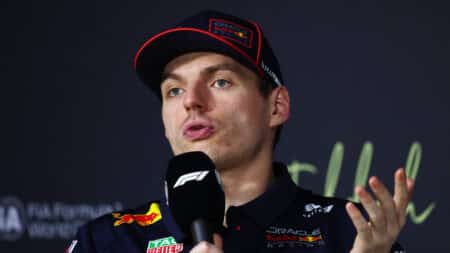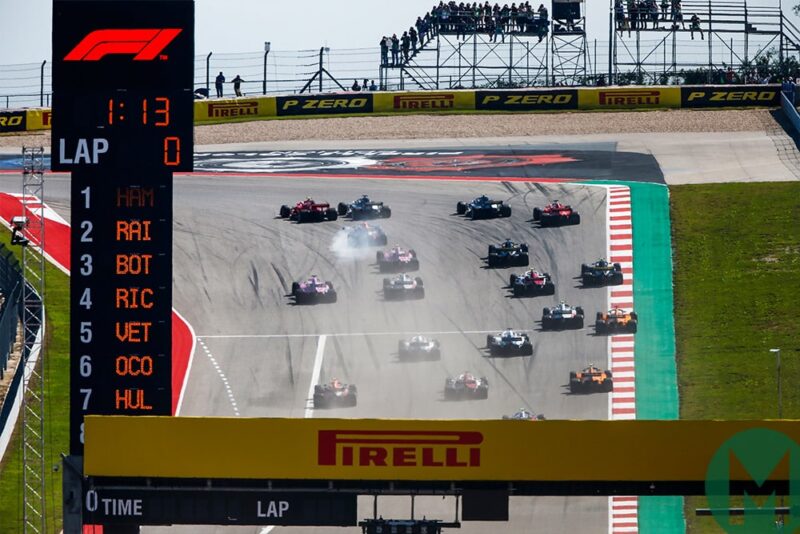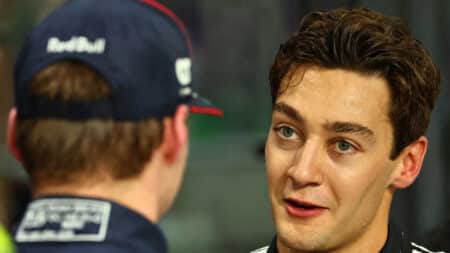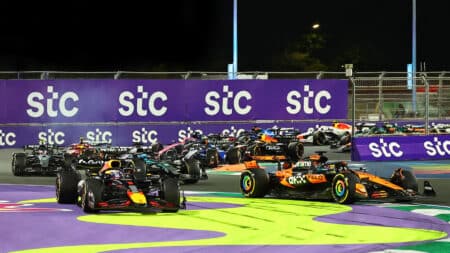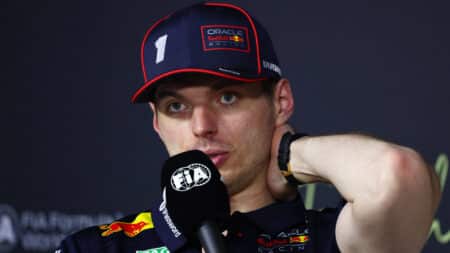Kimi! The 39-year-old jumped from his Ferrari like a teenager after quite the most beautifully judged victory, his first in more than five years, the first of his five-year second Ferrari stint.
Into the bargain, his judgement played a crucial role in Lewis Hamilton not clinching the championship. The way he fought the early stages of the race – how he defended when his ultrasofts gave out as Hamilton’s softs were still good – not only forced Hamilton into an extra stop but created the time deficit that his Mercedes just didn’t have the pace to overcome on a day when its tyre degradation was too heavy.
With the outcome of race and championship in doubt until almost the end, it was a brilliantly vivid event, the usual colours mixed up nicely by the lack of dry running on Friday and by Pirelli increasing the minimum pressures of the rears by 1.5psi on Saturday evening. The combined effect of those two factors took tyre degradation into unknown territory, left the teams unable to do their usual accurate simulations, and pivoted the race between a one-stop and a two. A further little nuance was that the changes also made the supersoft a better race tyre than the soft – and that allowed Max Verstappen to play a leading role in the race despite starting from 18th. Of the front-runners, he was the only one on the best tyre during the long second stint.
Most critical of all was how the tyre situation caught out Mercedes with a car that turned out to be hard enough on the rubber that it trapped it into an awkward tactical dilemma from which it made the wrong call, surrendering track position too cheaply without the performance advantage to buy it back.
Coming out from his second stop behind both Kimi Räikkönen and Verstappen, Hamilton was able to close them down on his fresh tyres but used up the best of their grip in getting up with them by the end. With a couple of laps to go, after a few seconds of wheel-to-wheel dicing with Verstappen led to the Mercedes getting on the marbles and leaving the track, the result was decided.
Sebastian Vettel – who’d yet again had a first lap incident, this time after contact with Daniel Ricciardo’s Red Bull – was able to pounce on Valtteri Bottas for fourth late in the race. It all deferred Hamilton’s crowning by at least one more race.
There was some irony in the fact that Räikkönen’s brilliant day was partly built upon the front-row start that Vettel’s grid penalty for a Friday red flag infringement had gifted him.
Qualifying
And just like that, Ferrari came back.
OK, it was another Hamilton pole – his ninth of the season – but Vettel made him sweat for it, just six hundredths shy. That was a small enough gap to induce Vettel into swearing on the slow-down lap. “When the gap’s that small you always feel like you could have done it,” he said.
Indeed, into the final corner Vettel was 0.06sec up on Hamilton, but he made just the smallest of errors there, running slightly too deep and having to ask too much of the front tyre. It was enough to swing it in Hamilton’s favour. Generally, Hamilton’s Merc was faster through the corners (particularly the Esses where he made up 0.3sec!) but the Ferrari was making up big chunks down the straights. The end result was those hundredths.
Of more significance was that Ferrari bounced back from the performance shortfall it’s suffered in the last few races. What had gone right? “I think maybe Lewis probably didn’t do a very good lap,” said Vettel mischievously. “Hey,” responded Hamilton from a few inches away. “The lap was good. I don’t do many bad laps.”
Would Ferrari’s new floor and bargeboards have made the difference? With Friday washed out there wasn’t enough dry running time to evaluate the big update and both Vettel and Räikkönen ran with the car in standard spec. Vettel was taking a three-place grid penalty for not having slowed enough for a red flag on Friday morning.
Whatever, the difference on this day of less than technical perfection – when the wind gusts were strong, the track cool and with insufficient data on the tyres – was the quality of the laps.
Hamilton: “We knew that it was going to be extremely close today and that we would have to give it everything. My first lap in Q3 was good, but it was really close between us all. I think I was ahead by less than a tenth [after the first Q3 runs] and I knew the others would improve, so there was no room for error. I had to make sure I improved in the second, which I haven’t always done this year.”
The Mercedes had taken a bit more fine-tuning than the Ferrari, having suffered from quite a lot of understeer in the first dry running of the weekend, earlier in the day. But come qualifying it was working fine, its direction change aided noticeably by how the rear of the car rotates beautifully when in roll, without that developing into any sort of slide.
Bottas was a chunky four-tenths off Hamilton around a track at which the latter always excels. He was mystified as to why he didn’t pick up the track’s greater grip on his final run.
Vettel’s penalty promoted third-fastest Räikkönen to the front row, a beautiful gift from his team-mate. He’d stuck with the faster ultrasoft tyre in Q2 in contrast to Vettel and the two Mercs, so was all set for an aggressive first stint. His tiny deficit to Vettel came in the first sector and was inevitably related to their respective tyre temperatures.
Only Ricciardo took part in Q2 and Q3 for Red Bull, as Verstappen’s car had pulled out a driveshaft in Q1 after being run hard over the sausage kerbs on the exit of Turn 15. For the second successive year at this place, he’d be starting among the minnows. A five-place penalty for a replacement gearbox would leave him starting 18th. Ricciardo did Q2 on supersofts, and in Q3 went on to his expected fifth place in the big gap between Mercedes/Ferrari and the Class B runners. The RB14 was again running the C-spec Renault.
Pole of ‘Class B’ this weekend was Esteban Ocon’s Force India, sixth fastest. Like last year, the Force India took a bit of massaging into a good balance and it really only came together in Q3. Team-mate Sergio Pérez was 10th, carrying a compromised aero balance because of damage to the bargeboards and floor picked up in Q1.
Ocon only just edged out Nico Hülkenberg’s Renault, who wrestled well when it mattered. “It felt quite tough out there in terms of car balance as it’s very windy and you really feel that in the car. The balance changes quite drastically from one corner to another which makes it quite tricky – and it didn’t feel too pretty.”
Carlos Sainz missed out on Q3 by two thousandths and was kicking himself for inadvertently pressing a button the steering wheel which cost him more than that. He would line up 11th.
The Haas didn’t have quite its usual edge over the other ‘Class B’ runners and Romain Grosjean was shaded by Hülkenberg’s Renault. He put it down to tyre temperatures on the cool track. Team-mate Kevin Magnussen was around 0.3sec off in Q2 and would line up 12th. “I just had a bit too much instability at the rear, which I struggle a little bit with.”
Charles Leclerc made Q3 in the Sauber and qualified ninth there. He’d gone sixth quickest in Q2 ahead of the Force Indias, Renaults and Haas, but in attempting to maximise the track grip on his single new-tyre Q3 run by going out as late as possible, he caught a light drizzle. Team-mate Marcus Ericsson went out in Q1 in penultimate place, with no particular problems.
Toro Rosso and Honda had elected to take engine penalties here to enable them to put in fresh power plants, which gave a useful performance gain, but entailed starting at the back. This is all about maximising the learning for next year. Pierre Gasly’s seventh-fastest time in Q1 suggested the combination had Q3 potential, but no further laps were completed. He was in the updated STR13 with new sidepods, with Brendon Hartley still in the older-spec car. He too qualified for Q2 but did only start practices once there.
Fernando Alonso (16th) hustled as best he could to go 0.5sec faster than McLaren team-mate Stoffel Vandoorne (who was slowest of all) but that still wasn’t good enough to make it out of Q1. The car was not reacting well to the ultrasoft tyres and was a bare tenth or so faster than Sergey Sirotkin who got most of what the Williams had to give and was 0.15sec quicker than team-mate Lance Stroll.
Race
Sunny but gusty in Austin as the red-sidewalled Hamilton sat on pole alongside the purple-sidewalled Räikkönen. The grippier tyres on the Ferrari were a big concern for Hamilton – one that proved fully justified as the lights went out.
From the right-hand side, Hamilton moved hard left more or less immediately, but it was too late: Räikkönen’s front wheels were already ahead of the back of the Mercedes. Räikkönen prevailed, Hamilton tucked in behind. Bottas got his elbows out through Turns 2-3 to keep Ricciardo behind, with Vettel next from the two Renaults, Hülkenberg ahead, Sainz working hard to fend off Ocon, with Grosjean, Leclerc, Pérez and Magnussen following on. The latter would soon be picked off by the charging Verstappen, with Pérez his next victim.
Through the Esses the midfield got mighty lairy, but amid the locked wheels Leclerc emerged ahead of Grosjean. Just behind, Alonso was the meat in a Williams sandwich, Sirotkin to his left squeezing him into Stroll on his right. The two made hard contact and Alonso was out. Stroll spun to the back and would be awarded a 5sec penalty.
Leclerc was aggressively on it and having elbowed past Grosjean was all over Ocon down the hill to the hairpin, then the following back straight, with Grosjean watching on trying to slipstream them both.
Vettel slipstreamed by Ricciardo at the end of that straight but it was marginal under braking into the 90-degree left of Turn 12, the Ferrari getting a big twitch, allowing Ricciardo to counter-attack into 13, swooping for the outside of the right-hander. Just behind, Hülkenberg and Sainz were side-by-side too, but just managed to keep out of each others’ way.
As this was happening, Leclerc was hit hard into 12 by Grosjean who had simply left his braking too late, locked up and hit the Sauber amidships. Both cars took on repairs but would later be retired.
Through Turn 13, Vettel hung on side-by-side until the Red Bull right-rear hit the Ferrari left-front. There seems no end to Vettel’s run of errors this year. Just like at Monza, the Ferrari spun, restarting near the back behind Vandoorne and the Toro Rossos, ahead only of Ericsson. Ricciardo continued unharmed and was pressuring Bottas’ third place by the end of the lap. Räikkönen had just flashed by the start/finish line already almost 2sec ahead of Hamilton.
So the foundation of the first stint was set, Räikkönen and Hamilton pulling clear of Bottas, while Verstappen and Vettel were into their recovery drives.
Whether this was a one or a two-stop race, no one was quite sure.
The raining-out of Friday meant very little data anyway, but in addition to that Pirelli had imposed an extra 1.5psi minimum pressure (up to 21.5 psi) for the rear tyres on Saturday evening after examination suggested a safety concern. This was almost 5psi above the optimum and promised to increase the degradation rates. Furthermore, the track temperature was around 8deg C higher than on Saturday.
The supersoft chosen for the first stint by the Mercedes, Vettel and Ricciardo in theory had a stint length around five laps longer than the ultrasoft being used by Räikkönen and the rest of the top 10. Theoretically, that meant those on supers had a better chance of having the range to make a one-stop feasible. But with nowhere near enough information for anyone, all bets were off. It was going to be a case of suck it and see. Verstappen, anticipating a long first stint getting through traffic, had chosen the soft (i.e. the hardest of the three compounds), a choice shared with Ericsson. The remainder began on supersofts.
“The car was really hard work right from the start,” said Hamilton afterwards. It wasn’t flowing as well as the day before, its rear tyre temperatures were constantly on the verge of running too high. Bottas was finding much the same with his. It may have had something to do with an issue in the garage earlier that morning. Both cars had been disassembled after parc fermé in order to replace their gearbox cooling water pumps, which were found to be leaking. As they were re-assembled, it seems the cars were not set up square, meaning the corner weights were out. This may have been key to the difficult day Mercedes was about to endure, although at the time of writing this was not certain.
There was no particular concern on the Mercedes pitwall in the early stages. The assumption was that as Räikkönen’s ultras inevitably began to degrade, Hamilton on his more durable supers would be able to pass him and get on with his own programme. That isn’t how it panned out. Partly this was an under-estimation of the difficulty in overtaking on-track. Historically, this has always been a great track for passing. But the additional downforce and marginal tyres on the increased pressures made it a whole lot more difficult this year. “You’d get to within about 1.5sec and that would be it,” said Hamilton. “Even when you’re 5sec behind you begin the feel the effect of the wake – and you begin to lose your tyres.”
On the fourth lap Räikkönen complained of ‘massive oversteer’ and it looked for a couple of laps as if the ultras were giving up prematurely. He lost 0.6sec to Hamilton on that lap, but on the next the problem somehow magically cured itself. The suspicion is that he’d picked up some debris from one of the first lap crashes and that it had lodged in an aerodynamically sensitive place before then dislodging again. At around the same time Hamilton picked up floor damage from debris, reckoned afterwards to have been costing him around 0.1sec per lap. As Kimi picked up the pace once more, Hamilton remained around 2sec behind, not wanting to get closer, just trying to keep the tyres in shape, but wrestling with the car more than he might have expected.
Verstappen was predictably scything through the field from his lowly grid position, Vettel doing a similar job from his early spin. Max picked off the ‘Class B’ leader Hülkenberg on the seventh lap to be running fifth, around 7sec behind team-mate Ricciardo. It would take Vettel a few more laps to find a way by the battling Force Indias and Renaults but he’d be there soon enough.
As Ricciardo went onto the throttle at the hairpin on the ninth lap, he got that sinking feeling. No response, no power. He pulled off to the side, his frustration very obvious. “Everything just switched off and it seemed pretty much identical to the issue I had in Bahrain at the beginning of the year. I couldn’t even communicate with anyone on the radio so it looks like a battery failure.”
After a lap or so, with the marshals still trying to move the Red Bull to a safe place, the Virtual Safety Car was put in place. Räikkönen, Hamilton and Bottas had just passed the pit entry. Would anyone be tempted? It was a little too early in the race for most as it would essentially mean committing to a two-stop. But on the Mercedes pitwall, they began to think about it for Hamilton.
Mercedes got enough of a gap over the rest of the field that it would only lose position to their own man Bottas, who would pull aside. It would get Hamilton onto fresh tyres with which he could then attack Räikkönen, with a better chance of overtaking him than when on equally old tyres. With the field reduced to VSC pace, to pit would lose you only 10sec rather than the usual 19.5sec. It would be a very cheap stop. Hamilton was instructed to do the opposite of whatever Räikkönen did. Räikkönen did a late little dummy, pretending to come in, then straightening up and continuing. Hamilton pitted – and was fitted with a new set of softs. He exited third, behind Bottas, who duly pulled aside once the VSC was rescinded on the 13th lap. Hamilton quickly closed down what had been an 8sec gap to Räikkönen and was right with the Ferrari again within a further four laps.
On his 20-lap old ultras, Kimi was slow and ever-slower. Hamilton engaged him in a dice and this only slowed them further for the next few laps.
“We think he’s on a two-stop,” Räikkönen was informed, the implication being to not delay himself fighting and to let the Mercedes by if need be. “Yeah, but let’s not do anything stupid,” replied Räikkönen, cautioning against that assumption. He continued to defend hard.
This had the effect of allowing Bottas, Verstappen and Vettel to close up. Verstappen and Vettel were the fastest two cars on track at this stage – as Hamilton’s new tyre grip was being wasted, trying to find a way by Räikkönen. On the 20th lap, he got DRS on him down the pitstraight. Räikkönen went to full attack engine mode in defence, with a tell-tale trail of oil smoke (something the Mercedes also does in its most extreme setting). On the following lap he was all over the Ferrari through the Esses, then trying for the outside of Turn 13. But Räikkönen remained cool, placing the car perfectly. He then peeled off into the pitlane for his new softs.
So the laps ticked by with blisters beginning to form around Hamilton’s rear left as Räikkönen and Verstappen chased him down…
Once free of Räikkönen, Hamilton was lapping at a pace that suggested he’d lost between 8-9sec behind the Ferrari – and this would have major repercussions.
Räikkönen rejoined a few seconds behind Vettel, who would be instructed to move aside for his fresh-tyred team-mate before making his own stop a few laps later. Verstappen was by now within undercut range of Bottas and Red Bull brought him in on the 22nd lap. Bottas was instructed to pit the following lap but his tyres had very little left to give, meaning his in-lap wasn’t quick enough to prevent him losing position to the Red Bull upon rejoining. Furthermore, because he’d started on the softs, Verstappen was now onto the supersofts at just the phase that the other front-runners were obliged to switch to the slower soft.
Vettel pitted on the 26th lap, had his softs fitted, and rejoined around 20sec behind Bottas. Up front, the earlier hare/tortoise scenario had been transposed, with Hamilton now leading on much older tyres and being chased down by the fresh-tyred Räikkönen, who was pulling along Verstappen in his wake. Bottas had faded somewhat and his job was now to hold off Vettel – which was crucial in championship terms. If Vettel remained fifth, Hamilton needed at least second to secure the title. On the Mercedes pitwall they were going for the win, which in hindsight was a mistake – Hamilton was about to be trapped, without enough pace or tyre life to pull that off.
He was not going to get the set of softs he’d had on since lap 11 to finish the 56-lap race. Räikkönen’s tyres were 10 laps newer, comfortably enough to get to the end. Vettel’s were newer even than that. Mercedes had reckoned Verstappen must be going to pit again as they couldn’t see that he’d be able to make a set of supersofts last 34 laps. However, the Red Bull is remarkably easy on its tyres and Verstappen had quickly sussed that the supersoft was a much better race tyre than the soft – which isn’t normally the case.
Knowing that it was going to have to stop again, and never having got a pitstop’s worth of gap over Räikkönen, the plan was to run Hamilton for long enough to maximise the pace advantage he’d have on his new tyres after his second stop – to maximise his chances of overtaking Räikkönen on track after stopping. Which meant letting Räikkönen get ever-closer. But in so doing, it allowed Verstappen to get within a pitstop’s worth of gap to Hamilton too. By the time it was realised Verstappen wasn’t going to stop again, it was too late. In stretching itself for the win against Räikkönen, Mercedes would end up losing a place to Verstappen instead. Had it been prioritising clinching the championship rather than winning the race, it’d have made a different decision.
So the laps ticked by with blisters beginning to form around Hamilton’s rear left as Räikkönen and Verstappen chased him down. With a pitstop taking around 19-20sec, the gap over Verstappen was perilously close to that as early as lap 25. It remained stable for a few laps as Verstappen concentrated on eking out his tyres. After a time, he was let off the leash. “You can brake 15 metres later for the corners now Max,” came the message.
With Hamilton now dropping into the 1min 40sec as his blisters worsened, Verstappen was in the low 1min 39sec. The last possible opportunity for Mercedes to pit Hamilton and emerge still clear of the Red Bull was lap 32 – and that came and went. Hamilton then caught traffic and dropped still further, emerging out the other side of it with his tyres now losing temperature. Mercedes realised it had miscalculated this one. Now there was nothing to lose in leaving him out yet-longer in order to maximise that tyre grip offset – and he finally made that second stop on lap 37, rejoining 12sec behind the new leader Räikkönen, with Verstappen just a couple of seconds behind the Ferrari.
Hamilton was immediately lapping 1sec or more faster than them. But when he asked what the gap was, he was dismayed to hear the answer. “How did it get to that? It’s too much.” He knew he’d use up all his extra tyre grip just in making up that gap – and that once he arrived on their tail a) his rubber would have given its best and b) he’d be repelled by their wake as if hitting a forcefield. Just as Verstappen had found when arriving on Räikkönen’s tail. Mercedes just didn’t have the pace or tyre usage to match its ambition on Sunday.
“I never know with you. I didn’t want a coming together…”
Meantime Vettel was biding his time in planning an attack on Bottas’ fourth place and, almost a lap behind, Hülkenberg held sway in ‘Class B’ from team-mate Sainz, who’d taken a 5sec penalty at his stop for gaining an advantage by leaving the track at Turn One on the first lap when defending from Grosjean. The Renaults were always just out of the reach of Ocon’s Force India. Pérez had been overcut for ninth by the Haas of Magnussen, who used the advantage of being on the supersoft rather than Pérez’s ultra on account of not having made the top 10 qualifiers.
Post-race, Ocon and Magnussen were each disqualified, the former for having exceeded the fuel flow limit on lap one, the latter for having used more than the permitted 105kg during the race.
With three laps to go, it appeared on the outside that any one of Räikkönen, Verstappen or Hamilton might take the win. But inside the cars, there was a more realistic realisation that this order was likely how it was going to stay. Hamilton had arrived on Verstappen’s tail by now and on the 54th lap took a look around the Red Bull’s outside through Turn 13. This move lasted all the way through the following sequence, with Hamilton briefly getting ahead only to run wide onto the marbles as they exited the long loop of Turns 17-18. “I thought you gave me a lot of room,” said an amused Verstappen later. “Yeah,” said Hamilton, “I never know with you. I didn’t want a coming together…”
At just this time Vettel was able to launch a successful attack on Bottas whose tyres were finished, the Ferrari slicing down the inside into Turn 12 with two laps to go. Given that Vettel had ended lap one 13 places behind Bottas, it supported Hamilton’s contention that the Ferrari was significantly faster than the compromised Mercedes on Sunday.
The Verstappen/Hamilton dice just played further into Räikkönen’s 39-year-old hands and as he gunned the Ferrari out the final turn he saw the chequer one more time. Maybe the last? “Oh, I dunno,” he said. “Maybe I win the next one too.”
View the full result
